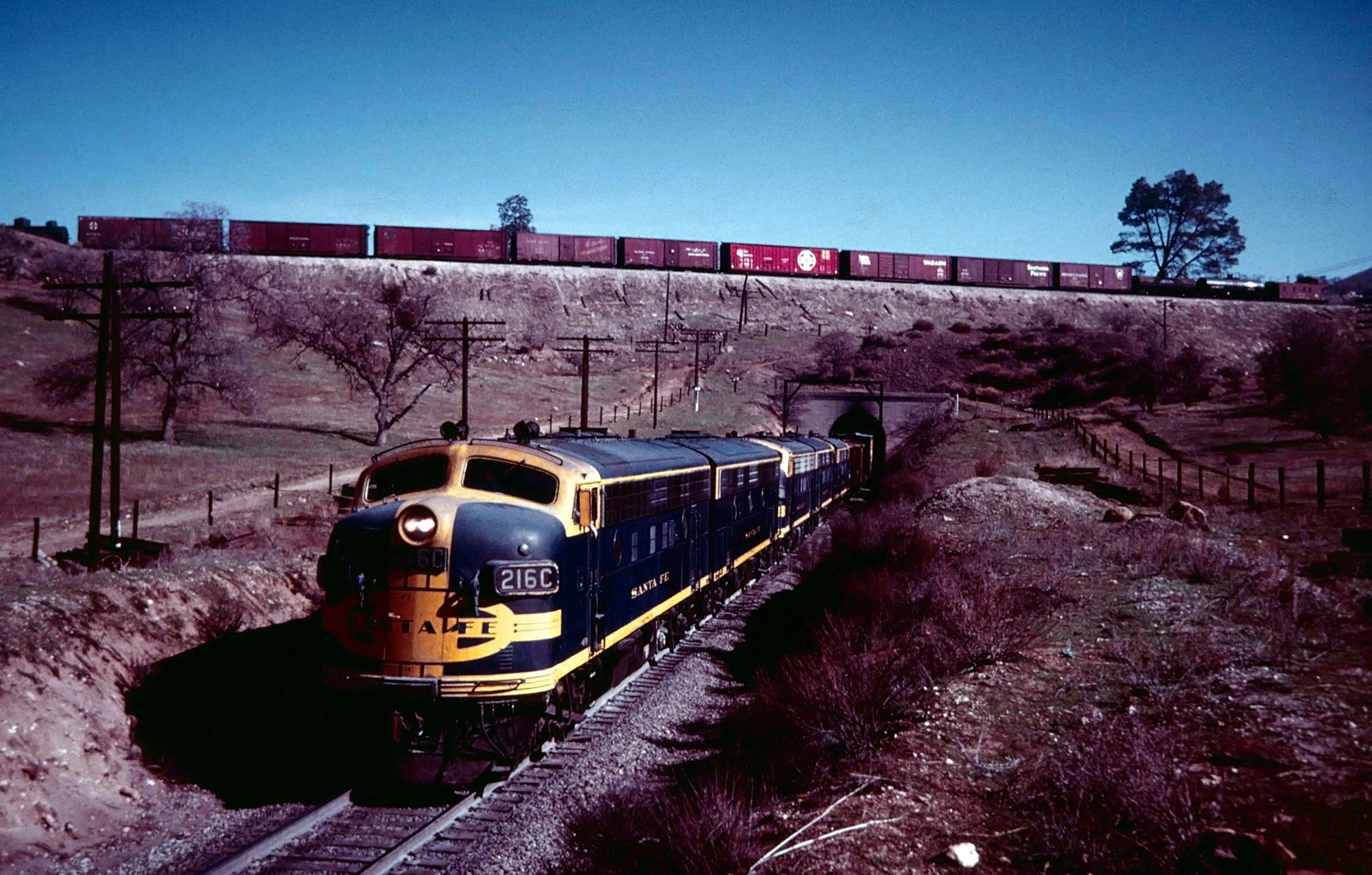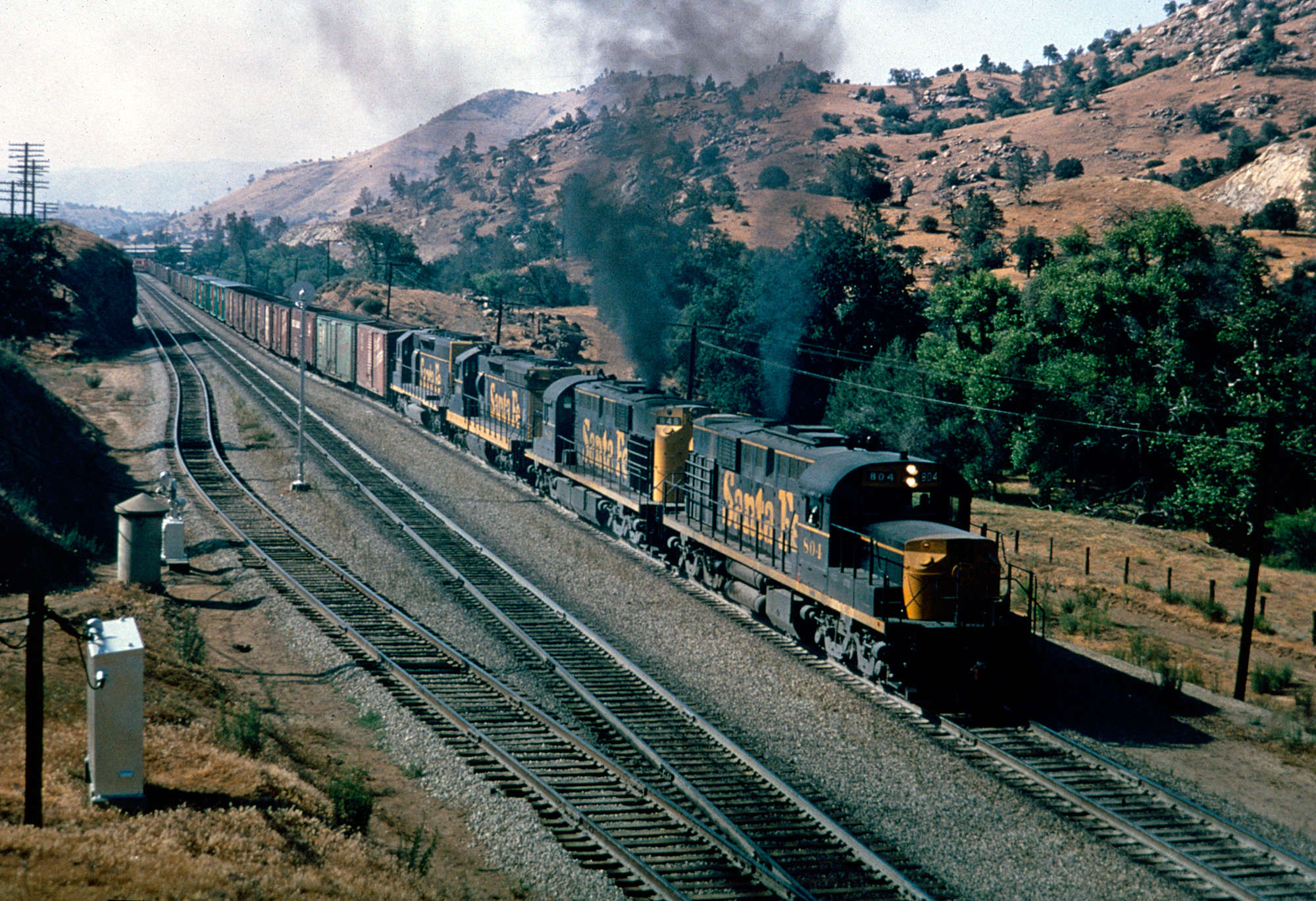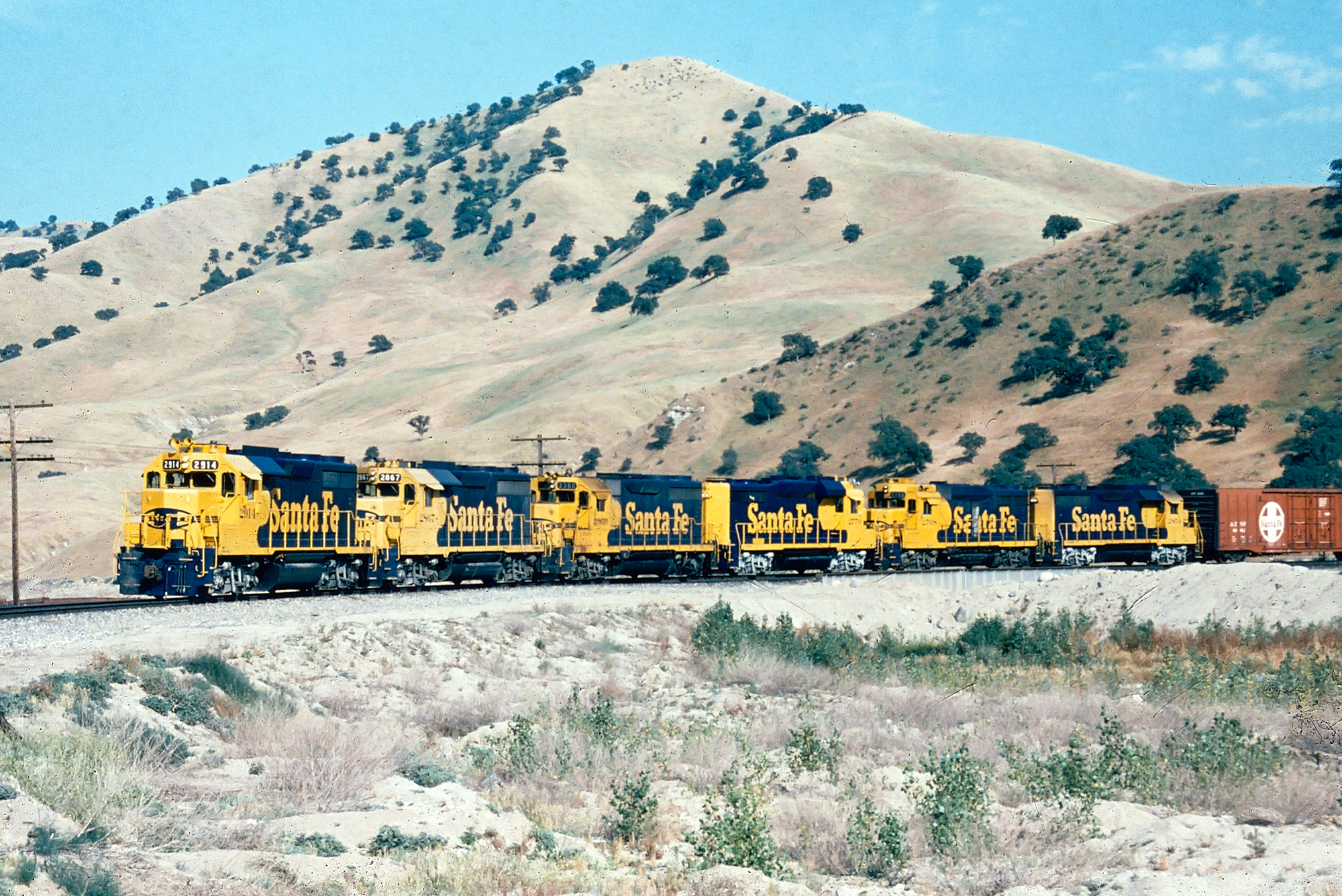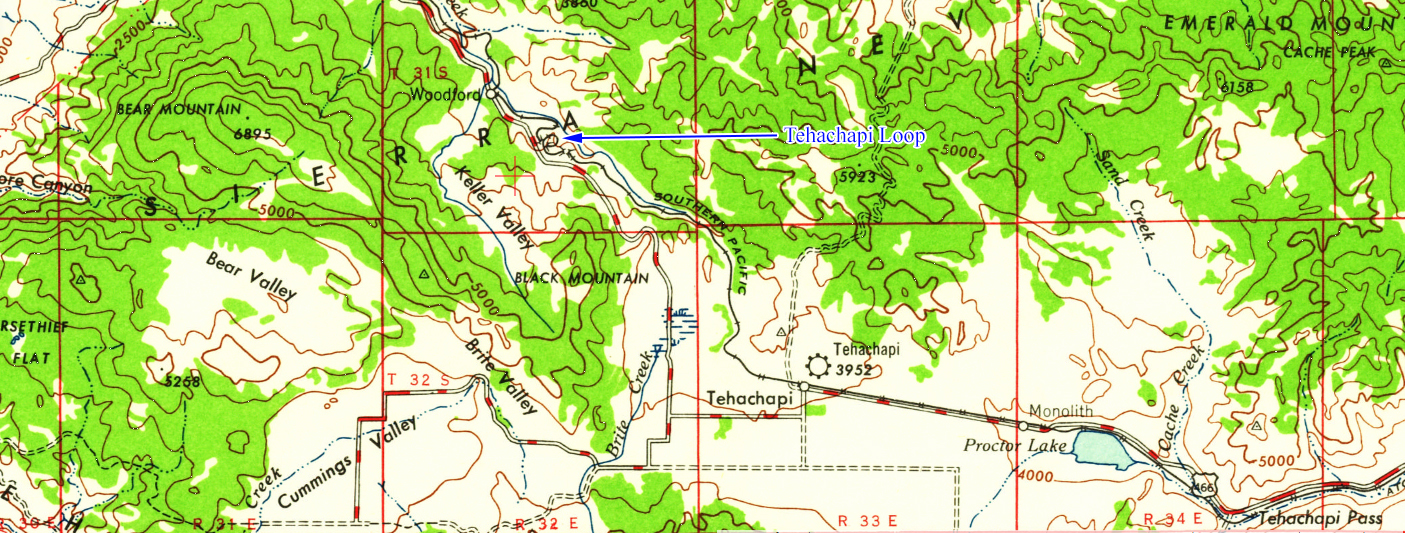The Tehachapi Loop
Last revised: October 12, 2023
By: Adam Burns
The Tehachapi Loop is a famous spiral section of a railroad through Tehachapi Pass in Southern California. Built by the Southern Pacific between 1874-1876, it is considered an engineering marvel for its ability to allow trains to traverse the steep Tehachapi Mountains.
Its intent was to gain elevation at a manageable gradient and has worked so well for nearly 150 years it has remained virtually unchanged and in regular use.
The loop extends 0.73 miles with a diameter of 1,200 feet and a height difference of 77 feet between its highest and lowest points. It is still a vital part of the area's transportation infrastructure and is now a National Historic Civil Engineering Landmark. Today, it remains an important artery of Union Pacific.
When the railfan hobby gained steam after World War II, folks flocked to the site to not only watch the trains but also view the area's stunning scenery.
Tehachapi was always a railfan favorite; not only did trains cross over themselves but also involved more than just Southern Pacific movements.
From its early days, the Santa Fe enjoyed trackage rights over the pass offering enthusiasts the chance to see multiple liveries and operations.
Photos
 In this scene, Santa Fe F7A #216-C, and several other F units, work their way west over Tehachapi at Walong, California. Fred Worsfold photo. American-Rails.com collection.
In this scene, Santa Fe F7A #216-C, and several other F units, work their way west over Tehachapi at Walong, California. Fred Worsfold photo. American-Rails.com collection.History
The tale of the Tehachapi Loop starts in the heady days of railroad expansion in the late 19th century. Construction began in 1874, under the control of Southern Pacific.
A race had been sparked to connect the burgeoning markets of California with the rest of the United States, a task previously attempted only by the Central and Union Pacific via the rocky Sierra Nevada Mountains.
One of railroading's most impressive feats of engineering, the loop was completed on February 24, 1876, ushering in a new era of transport and connectivity. During its construction SP sought a way to navigate California's treacherous Tehachapi Mountains while adhering to stringent grade regulations.
The demanding terrain required an impressive workforce of around 3,000 Chinese workers. Given the period’s rudimentary construction tools - including picks, shovels, horse drawn carts, and blasting powder - this significantly vast labor force truly underlined the monumental nature of the task at hand.
The spectacular loop is located in Kern County, Southern California, scaling the heights of the Tehachapi Mountains. In terms of direction, it falls between Bakersfield and Mojave.
 A pair of Santa Fe RSD-15 "Alligators," #804 and #849, and a few EMD units work hard on an eastbound climbing Tehachapi at Woodford, California during the early 1970s. Photographer unknown. American-Rails.com collection.
A pair of Santa Fe RSD-15 "Alligators," #804 and #849, and a few EMD units work hard on an eastbound climbing Tehachapi at Woodford, California during the early 1970s. Photographer unknown. American-Rails.com collection.Engineering
The best grade through the region was the Tehachapi Pass, located along the northwestern section of the mountain range, and is where the SP ultimately decide to lay its line.
Its design is the work of William Hood, Southern Pacific's Chief Engineer. His practical and innovative plan conceded to the harsh landscape while effectively conquering it. Other contributing engineers to the project include Arthur De Wint Foote and James Strobridge.
Its ruling grades are an essential factor in its design; it's set at a steady 2.2%, the maximum permissible grade for efficient traction. Stretching over 3,799 feet and approximately 0.73 miles long, the Loop is a marvel of engineering ingenuity, an undulating ribbon of track that neatly coils in on itself.
A crucial element of its architecture is Tunnel #9. Cutting cleanly through the mountain, this 428 foot long tunnel enabled the loop to fully curve into itself, creating the helix that provides the necessary elevation gain.
Construction
The Loop's diameter measures approximately 1,210 feet, while displaying an impressive elevation gain of nearly 77 feet; the equivalent of climbing an eight-story building. The entire length of the line through Tehachapi Pass, capped by the Loop, is 28 miles.
When originally completed, the Tehachapi line featured 18 tunnels, 10 bridges, and several water towers for steam locomotives. Its completion marked the final component of the SP's San Franscisco-Los Angeles main line. it was part of the final line of the first railroad to connect San Francisco with Los Angeles.
Map
Hood's loop used cut and fill methods to keep the grade at no greater than 2.2%, which, of course, featured a short tunnel and overpass. It ultimately covered about ¾ of mile gaining an impressive 77 feet in elevation over the short distance.
The Loop was officially completed two years later in 1876 and was not only Hood's crowning achievement of his career but also cemented him in the annals of history as one of the great engineers of all time.
 Santa Fe GP35u's #2914 and #2867, GP35 #3360, GP30u's #2779 and #2768, and GP35u #2854, lead a westbound around the horseshoe curve at Caliente, California on Tehachapi, circa 1983. Mike Bledsoe photo. American-Rails.com collection.
Santa Fe GP35u's #2914 and #2867, GP35 #3360, GP30u's #2779 and #2768, and GP35u #2854, lead a westbound around the horseshoe curve at Caliente, California on Tehachapi, circa 1983. Mike Bledsoe photo. American-Rails.com collection.Historical Operation
Another interesting aspect is that Southern Pacific wasn't the sole user of this track. Under an agreement with, the Santa Fe - which later arrived to Southern California - also had the privilege of trackage rights over the Loop.
For those keen to explore the Loop's history, the Tehachapi Depot Museum is a treasure trove. Positioned centrally in Tehachapi, this museum curates a comprehensive collection of railroad lore.
At the time of the loop's completion, however, no one could have imagined the length trains would reach. Today, with train's more than a mile it is possible to see the unique phenomenon of watching Union Pacific and BNSF Railway freights crossing over themselves, which is a major draw for railfans along with the many trains that pass through the area each day.
Throughout the years there have been a number of impressive photographs taken capturing this phenomenon and the panoramic scenes are quite breathtaking.
However, perhaps no other time was more interesting on Tehachapi than during the steam and passenger era. Before Amtrak took over most intercity passenger services on May 1, 1971 one could witness trains such as SPs overnight Owl (San Francisco/Oakland - Los Angeles) and appropriately-named Tehachapi (Fresno - Los Angeles) swing around the loop.
In addition, the railroad's legendary "Cab Forwards" could be seen working hard handling time-sensitive perishable traffic and Santa Fe FT's doing the same. Today, of course, things are much different and passenger trains are no longer utilize the loop.
Today
The Loop passed into the hands of the Union Pacific after its merger with Southern Pacific in 1996. Today, this railroad artery remains as vital as ever, witnessing between 30-40 trains each day.
Despite well over a century of operation, the Tehachapi Loop continues to be a challenging piece of railroad real estate. But with their simultaneous focus on safety and efficiency, Union Pacific remains committed to managing the location's unique topographical complexities.
Seeing a mile-long train wrapping over itself, as it climbs the steady grade of the Loop, is a sight to behold. Even today, in an age of soaring skyscrapers and space travel, it sustains a mesmerizing lure.
Whether as a practical response to a challenging landscape, or an impressive feat of human ingenuity, the Loop highlights the indomitable spirit of the era. A testament to determination and resilience, it serves as a lasting monument to the industry that once conquered the continent.
Beyond its practical utility, the Loop has also stood as an alluring subject for historians and rail enthusiasts alike. Its construction saga and operational history have been told and retold, often through the mechanism of model train sets capturing the romance of this epochal curve.
The Loop also makes a popular spot for railfan photography. With an overlook dedicated to spectators, it provides outstanding views of the trains below as they weave their paths on the helix-shaped track.
In recognition of its significant role in California's history, the Tehachapi Loop was designated a California historical landmark in 1998, and later, a National Historic Civil Engineering Landmark by the American Society of Civil Engineers.
While technological advancements may render certain features of the rail industry obsolete, the Loop's continued usage goes to highlight its engineering prowess and unique contribution to rail transportation in America.
As we look back, the Tehachapi Loop stands as not just a feat of engineering but a testament to the human spirit and its continuous quest for progress.
It reminds us that within the stories of the railroads, like the Southern Pacific and Santa Fe, lie narratives of adventure, perseverance, innovation, and the timeless endeavor to venture into the unknown.
SteamLocomotive.com
Wes Barris's SteamLocomotive.com is simply the best web resource on the study of steam locomotives.
It is difficult to truly articulate just how much material can be found at this website.
It is quite staggering and a must visit!

